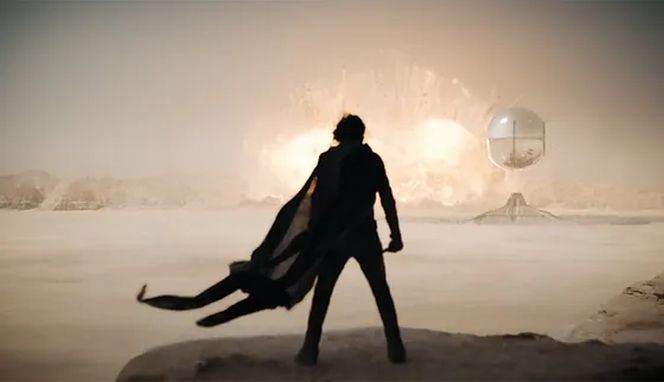MOVIE REVIEW – Denis Villeneuve and Timothée Chalamet return with a stunningly complex blockbuster that redefines high-budget cinema. Dune: Part Two is not merely a continuation; it is an artistic creation filled with depth of thought and vision, surpassing its predecessor and setting a new standard in the sci-fi space opera genre. This installment is memorable not only for its incredible visuals and storytelling but also for the complexity of its characters and the ethical dilemmas it presents.
Since the announcement of the Harry Potter and the Deathly Hallows films, two-part films have become somewhat of a plague on blockbusters. At best, they appeared as stretched, profit-maximizing attempts; at worst, as two incomplete halves that together still failed to form a convincing whole. But Denis Villeneuve’s adaptation of Dune stands out as an exception. The first film, publicly known simply as Dune and only revealed as Dune: Part One in the credits, had to wrestle with world-building and all its explanatory facets. All this came with the silent promise that the finale would transform the story into a breathtaking, seat-clutching sci-fi epic. And Dune: Part Two delivers exactly this magic.
On the Path of the Messiah
The first part introduced us to the adventures of the Atreides family and their young scion, Paul (Timothée Chalamet), who came to possess Arrakis, the universe’s sole source of the highly valuable spice. Soon after, the Atreides face betrayal by the previous rulers, the Harkonnens, who reclaim the planet, nearly exterminating the Atreides. Only Paul and his mother, Jessica (Rebecca Ferguson), survive, hiding deep within the deserts of Arrakis.
This introduction is key because the sequel wastes no time on unnecessary repetition. Dune: Part Two picks up directly where Paul and Jessica integrate into the community of the native Fremen, who consider the harsh desert their home. Jessica, following the mysterious plans of the space-witch Bene Gesserit order, continues to propagate that Paul is the awaited messiah of the Fremen, eventually becoming their spiritual leader herself.
Meanwhile, Paul quickly gains recognition as a Fremen warrior, thwarting the Harkonnens’ efforts to restart spice production on Arrakis, primarily through guerrilla warfare and raids. Paul, along with the Fremen warriors, Chani (Zendaya), Stilgar (Javier Bardem), and others, launch surprise attacks against the Harkonnens’ massive spice-producing sand crawlers, exploiting Arrakis’ native giant sandworms and the laser weapons that slice through vehicles in seconds.
These scenes make Dune: Part Two truly spectacular early on, brilliantly syncing the colossal size of the Harkonnen desert vehicles with the Fremen’s fierce yet artistic close-combat techniques. The characters skillfully maneuver between the giant legs of the sand crawlers, dodging the sharp gaze of overhead ornithopters, while their comrades fight with fists, knives, and firearms behind them. This masterful play between intimate violence and grand spectacle is brilliantly utilized by Villeneuve in the dynamics of Part Two.
The film’s first hour is filled with these unexpected raids, each a thrilling, unexpected gift to the audience. These actions gradually lead Paul to his destiny: leading the Fremen in a battle to reclaim Arrakis from the Harkonnens, and possibly overthrowing the emperor who cunningly wove the conflict’s threads. The excitement of this chosen-one narrative is enhanced by Paul’s reluctance to embrace this power, knowing that his ascent, as foretold by prophecies, will bring endless death and destruction across the universe. While all the adults around him push him towards this fate, only Chani stands by him, as Paul slowly recognizes the benefits of power and its inevitable, fateful nature.
Charismatic Messiah or Tormented Youth: Chalamet Brilliantly Portrays Both Sides of Paul
Dune: Part Two masterfully unfolds Paul’s complex character development through stellar direction and storytelling. Chalamet excels in portraying Paul’s dual nature as both a charismatic leader and a young man wrestling with internal conflicts. The seamless transitions between these aspects highlight that, no matter which side Paul shows, the weight of the other always lurks in the background. When Paul leads the Fremen’s fight, it’s evident he is as scared as he wishes his enemies to be. Alongside Chalamet’s impressive performance, it’s Zendaya who lends authenticity to the moral depths of Part Two.
In the film’s most intimate moments, with just the two of them present, Zendaya contributes a raw sensitivity that further highlights the emotional depths of Chalamet’s Paul. Their chemistry allows them to explore depths and complexities in their characters far beyond the simplified narratives of typical blockbuster films, dissecting complex moral and cultural dilemmas instead of the usual epic love declarations.
The trio of special talents concludes with Feyd-Rautha Harkonnen Na-Baron, played by Austin Butler, sent to Arrakis to end Paul’s actions and exterminate the Fremen. Feyd-Rautha, even more bloodthirsty than his brother, Baron Vladimir Harkonnen (Stellan Skarsgård), is a born psychopath. Butler’s presence in each scene conveys the character’s dark allure, and Villeneuve skillfully uses Butler’s rock star charisma to craft a character who is at once alien and perfectly fits within the world of Dune.
Feyd-Rautha’s introduction is particularly notable when he appears in a ceremonial duel in the arena of the Harkonnens’ planet. This scene is exceptionally shot using black-and-white infrared technology, casting every detail in a unique, eerie light. Not only does this provide a memorable introduction for Feyd-Rautha, but it also offers deeper insights into the inner workings of Harkonnen society through sheer visual and atmospheric power. While this visually bold choice could easily overshadow the rest of the film, Villeneuve manages to integrate it so perfectly that it enhances the stunning visual sequence of Dune: Part Two.
Visuals No Longer Just Ornamental
Denis Villeneuve’s sci-fi universes, such as Arrival, Blade Runner 2049, and Dune: Part One, have always captivated audiences with their monumental visuals. In these films, the spectacle often appears almost magical, enchanting but sometimes distracting. Villeneuve tends to start with a simple, everyday element and gradually reveal a breathtaking, immense structure or natural wonder.
Thus, it’s hard to fault Villeneuve for the instinctive desire to showcase and marvel at the visual wonder his team has created, especially with how skillfully he weaves together the realms of nature and digital effects. This approach has proven effective time and again, mesmerizing the viewer. However, these moments can distract, prioritizing visual grandeur over the story, even if only momentarily.
Dune: Part Two, however, opens a new chapter in Villeneuve’s career. The film is as stunning as its predecessors, if not more so. Here, the visual wonders naturally fit into the narrative, enhancing the content and dynamics of the scenes rather than distracting from them. Villeneuve has never so openly trusted his visual instincts for storytelling. This creative confidence declares that the film is not built on a single memorable frame but on a series of beautiful, breathtaking visual experiences that harmonize perfectly with each other, thus elevating the art of spectacle to a higher level.
A Masterclass in Narrative and Visual Harmony
Dune: Part Two is a creation filled with delicate balancing acts, masterfully navigating between the grandiose world of monumental sets and the personal drama of close combat. This film skillfully mixes traditional hero tales, which have become the hallmark of blockbuster cinemas, with complex questions that probe the dangers of wielding power and exercising violence. Here, the grand visual presentation is not just decoration but carries deeper layers of content.
This richness is possible because Dune: Part One had already laid the necessary groundwork. For fans of the series, Part Two promised that the conclusion of Paul’s story would be even more stunning, visually rich, and emotionally impactful than they could have hoped. For those who found the First Part perhaps too slow or overloaded with explanations, the sequel promised a more focused, dynamic narrative. Dune: Part Two fulfills this promise: a rare sequel that not only surpasses its predecessor but retrospectively enhances its value. It is more than a worthy continuation of Villeneuve’s epic adaptation: this film rightfully ranks among the most outstanding blockbusters and the best sci-fi classics of the century.
-Herpai Gergely (BadSector)-
Dune: Part Two
Direction - 9.6
Actors - 9.5
Story - 9.5
Visuals - 9.8
Ambience - 9.8
9.6
MASTERPIECE
Denis Villeneuve and Timothée Chalamet return with an impressively complex, large-scale cinematic creation. Dune: Part Two not only continues the story of the previous installment but elevates it to a higher level in every respect. The film's magical visual world, the profound portrayal of its characters, and the philosophical richness of its themes make it not just a worthy sequel to Villeneuve's epic first Dune film but also one of the most memorable sci-fi masterpieces of recent decades.



















Leave a Reply